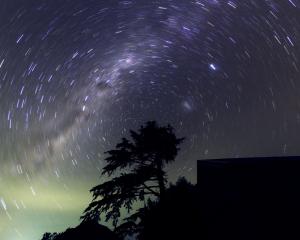Moose hunter Ken Tustin this winter once again returned to Herrick Creek, near Wet Jacket Arm in Fiordland, in his latest bid to collect evidence of the animal's continued existence in this country. So, do wild moose still live in New Zealand? Murray Kirkness and Stephen Jaquiery went with him to try to find out.
What drives a man to search on and off for 37 years in one of the world's most remote locations for an animal which is in no way endangered; to spend weeks and months camping out in isolation and in miserable conditions; to endure, at times, ridicule; to constantly open himself up to ongoing disappointment?
For Ken Tustin (63) the question is complex, but at the heart of his quest is a simple - some would say romantic - notion.
It is all about mystery.
"I love the intrigue of it all. I love the idea that mankind thinks he knows what drives this planet and that he has the answers to all the mysteries in it. But we don't. And this is one of the last fair dinkum mysteries still out there," Tustin, wiping rain from his face, says.
"These things [New Zealand moose] have been hoodwinking everyone for years. If we find one, it will capture people's attention . . . it will really challenge conservation attitudes in this country.
"And you can just imagine people saying `isn't New Zealand's wilderness amazing - it can hide a big animal for 60 years'."
He's right about that.
New Zealand's wilderness - certainly this part of it - is amazing.
And I have no doubt it is dense enough to hide very many animals.
Whether those animals include moose, some are not so sure.
We are in Herrick Creek, in early winter, surrounded by countryside that is storybook-cliche Fiordland - hanging mist, dripping ferns, moss-covered beech trees, myriad shades of green in every direction when you do get a glimpse through a break in the low clouds.
It's almost other-worldly.
To use Ken's description, it's mystical.
And, of course, it's wet.
Today only drizzle is falling, but in the weeks leading up to our one-day fly-in, fly-out trip to check Ken's motion-triggered trail cameras, it has been very wet indeed, even by Fiordland's standards.
Ken doesn't seem to notice the precipitation, nor the soggy conditions underfoot.
He is focused on his hope that the cameras have functioned without mishap, and maybe even captured a photo that hasn't been taken in this country since 1952 - that of a wild moose.
Ken's search for moose in Fiordland began in earnest in 1972.
His efforts since have been well-documented in this country.
He has been joined on numerous hunts since 1991 by his wife Marg.
In fact, they have spent 14 months during those past 18 years searching for moose in Fiordland, and Ken has spent more than three months camping there on his own.
All he has to show for his efforts are a cast moose antler, several hairs which DNA tests later revealed to be from moose, one blurry photograph that may or may not be the species in question, some "sign" and much anecdotal evidence.
He's never seen one here in the flesh - yet he holds the same unshakeable belief in the animal's continued existence in this country's biggest national park as when he began his quest.
One gets the feeling that, just perhaps, he doesn't really mind if he doesn't find a living example of Alces alces in Fiordland.
He certainly doesn't care if he and Marg cannot provide photographic evidence that will satisfy the many scoffers they encounter.
"When you get ridiculed you do ask yourself whether it's worth it . . . but, you know, I don't care if we don't knock it off in our lifetime. I know they're here."
As we traipse through the thick bush, I ask him what he will do if and when he sees one.
"Well, I think I'll be very lucky to see one on foot. I'd just be . . ."
His voice tails off.
It cannot possibly be the first time he's been asked the question, but there's a long pause while Ken considers his reply.
"If I saw one, I'd just enjoy the moment. I wouldn't even look for my camera, because sure as hell it'd only be there for about a quarter of a second before bolting."
Ken Tustin's name is widely recognised in New Zealand.
The university graduate has been a professional hunter, research scientist, author, helicopter pilot and wild game animal consultant who has produced reams of material about tahr, located in the Antarctic a long-lost food cairn belonging to Robert Falcon Scott, and found an early Maori midden on a South Otago beach.
But it is through his pursuit to prove that moose still survive in Fiordland that he is most widely known.
Despite his sanguine approach in the bush, he had earlier admitted to feeling nervous when we left Te Anau on the flight in.
Ten cameras, all sponsored, have been in place since December 2008, and he's anxious to see how they have stood up to this most testing of environments.
His worries ease when we find the first camera.
According to its digital read-out, it still has 68% battery power and has taken more than 300 photos in the 150 days it has been operating.
We change the batteries and switch data cards, carefully placing each of the small discs in plastic cases with numbers which correspond with each camera.
Then it's off to the next camera.
Each time we remove a memory card, I wonder if this is "the one".
Ken doesn't seem so affected by the possibility.
He often mumbles quietly, seemingly to himself, pondering angles and tree branches and game trails and looking for moose sign and tree damage, but is certainly not what I would call fidgety about the possibility that he may, just may, have captured an image that would undoubtedly make a fair number of people in this country shake their heads in wonder.
Towards the end of the day, he begins to discuss his work, for want of a better word, in such a secluded and unforgiving, but also profoundly beautiful, part of the world.
"You can be pretty despondent, especially if you're doing a long solo trip in here.
You work so hard for such small incremental increases in knowledge.
It can be a tough environment and it can be quite demanding.
"But on the other hand it can be quite rewarding. I love it down here. It's a very special place. And I enjoy the personal challenge of doing it, and getting it right."
I ask if he'll turn to more gentle pursuits once he has proved beyond doubt - to everyone else - that moose still survive in Fiordland.
"I'll look for another animal; one which lives on a warm beach, which gets up at 10am and goes back to bed at 2 in the afternoon," he says with a laugh.
After several hours and a couple of short helicopter flights, we have collected the cards from all 10 cameras and set up another three.
A 45-minute flight back to Te Anau, a change out of sodden wet-weather gear and we're sitting in the office of Richard "Hannibal" Hayes with two computers fired up and a total of 3500 images to scan for moose.
At least two of us in the room seem excited.
Marg, who has met us to go through the pictures, is more relaxed.
Ken? Well, Ken is so laid-back he tells us to begin and then heads to the kitchen to boil the jug.
I cannot believe that he doesn't want to be there to see what his cameras have found.
He returns with welcome mugs of steaming hot sweet black tea, to find that his cameras have recorded plenty of shots of deer - both by day and night - and just as many of waving tree branches.
Each time an animal is spotted on the thumbnail-sized pictures, hopes are raised, but an hour or so later we realise there are no moose on "film".
I feel a bit flat, but Ken and Marg happily pack up their gear and leave the hangar.
Ken's satisfied the cameras performed well and are still out there, shooting pictures day and night.
There's always next time.
And, after all, he doesn't need photographic evidence - he knows the moose in Fiordland are real.
- One of the motion-activated cameras is sponsored by the Otago Daily Times. At least two of the newspaper's editorial staff like to believe moose still survive in Fiordland.
Moose let loose
1900: Four young moose - said to be as tame as pet ponies and keen on eating biscuits by the time they arrived by ship in New Zealand - are imported from Canada and shipped to Greymouth from Wellington.
Railed to Hokitika, they were temporarily kept in stables before being released near the Hokitika Gorge on February 19, 1900.
Three animals disappeared up the gorge.
Some accounts suggest at least one of these animals survived until about 1903.
The fourth, a cow, remained near Vine Creek for 14 years and was an occasional visitor to the settlement of Koiterangi, apparently still searching for biscuits.
1910: Ten hand-raised Canadian moose - six females and four males - shipped to New Zealand, arriving in Wellington via Hobart.
After being quarantined at Somes Island for nearly two months, they were shipped to Bluff, transferred to a government steamer and released at Supper Cove, Dusky Sound, Fiordland, on April 6, 1910.
One female breaks its leg at the shoulder in a fight with another animal upon release.
One cow shot within weeks of liberation.
1923: First photograph of a wild moose in New Zealand taken.
The animal was photographed by Charles Evans at Supper Cove before it swam across the Seaforth River.
1925: Two cows seen swimming across the flooded Seaforth River at Supper Cove.
1927: Two young bulls seen and photographed in the Seaforth Valley in the month of May.
A cow was seen the following day.
Les Murrell photographs two bull moose in the Seaforth in July.
1929: Eddie Herrick, operating on a prospecting licence with guide Jim Muir, in March shoots a bull moose "well past its prime".
It may have been one of the animals originally released.
1934: Eddie Herrick shoots another bull, this time in the creek that now bears his name.
1950: Young bull shot near Supper Cove by Gordie Cowie.
1951: Jim Mackintosh shoots a cow in Herrick Creek.
Robin Francis Smith shoots a cow in the Henry Burn.
1952: Max Curtis photographs a cow near the lake on Herrick Creek.
Percy Lyes shoots a bull at Herrick Creek, for years considered to be the last moose shot in New Zealand.
Robin Francis Smith later takes 14 photographs of a cow at Herrick Creek.
For 57 years it has been the last confirmed moose sighting. Source: A Wild Moose Chase, by Ken Tustin.















